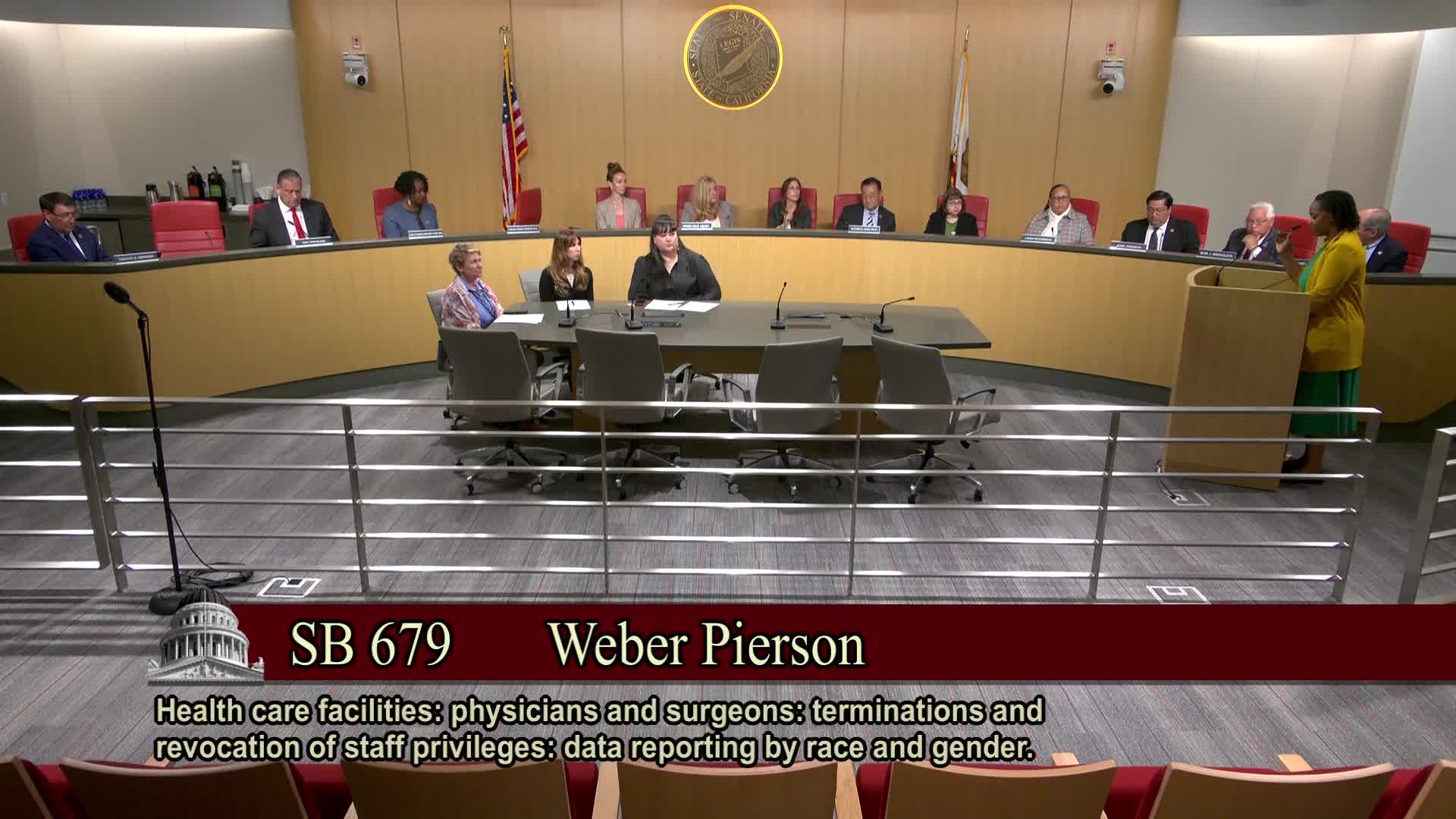Bill to collect statewide, de‑identified data on hospital credentialing and disciplinary actions advances after committee testimony on racial disparities
April 21, 2025 | California State Senate, Senate, Legislative, California
This article was created by AI summarizing key points discussed. AI makes mistakes, so for full details and context, please refer to the video of the full meeting. Please report any errors so we can fix them. Report an error »

Sen. Weber Pearson’s SB 679 would establish a statewide, de‑identified reporting system for hospital credentialing and privilege decisions so a state civil‑rights agency can analyze whether race, gender, or other demographic factors correlate with adverse credentialing outcomes.
The author described long‑standing concerns about differential investigation and discipline of physicians from underrepresented groups. She cited a 2017 California Research Bureau study finding racial disparities in investigations and discipline, and national data from the Accreditation Council for Graduate Medical Education indicating higher dismissal rates for Black residents. "When these decisions happen behind closed doors without accountability, it becomes impossible to tell whether a physician was treated fairly, or if bias played a role," the author said.
The Golden State Medical Association, physician witnesses and other supporters urged data collection to identify systemic patterns. Dr. Khadija Lang, president of the Golden State Medical Association, said the organization seeks parity and justice in medicine and argued that losing underrepresented physicians worsens health‑care disparities. Dr. Thurman Hunt, an anesthesiologist who testified, described being suspended and later exonerated after an external review and said the emotional and professional consequences can push physicians to leave practice or the state.
Supporters emphasized the bill would collect non‑identifying demographic information and would send reports to the state civil‑rights authority rather than the Medical Board, and that amendments would remove the Medical Board from reporting responsibilities. The sponsor said the data are intended to detect patterns, not to punish individual hospitals or clinicians.
No opposition witnesses appeared in the committee hearing. The committee voted to pass SB 679 as amended to Senate Judiciary Committee. The author and witnesses said the bill is intended to protect physicians and patients by highlighting systemic disparities that can reduce the physician workforce and worsen outcomes in communities of color.
The author described long‑standing concerns about differential investigation and discipline of physicians from underrepresented groups. She cited a 2017 California Research Bureau study finding racial disparities in investigations and discipline, and national data from the Accreditation Council for Graduate Medical Education indicating higher dismissal rates for Black residents. "When these decisions happen behind closed doors without accountability, it becomes impossible to tell whether a physician was treated fairly, or if bias played a role," the author said.
The Golden State Medical Association, physician witnesses and other supporters urged data collection to identify systemic patterns. Dr. Khadija Lang, president of the Golden State Medical Association, said the organization seeks parity and justice in medicine and argued that losing underrepresented physicians worsens health‑care disparities. Dr. Thurman Hunt, an anesthesiologist who testified, described being suspended and later exonerated after an external review and said the emotional and professional consequences can push physicians to leave practice or the state.
Supporters emphasized the bill would collect non‑identifying demographic information and would send reports to the state civil‑rights authority rather than the Medical Board, and that amendments would remove the Medical Board from reporting responsibilities. The sponsor said the data are intended to detect patterns, not to punish individual hospitals or clinicians.
No opposition witnesses appeared in the committee hearing. The committee voted to pass SB 679 as amended to Senate Judiciary Committee. The author and witnesses said the bill is intended to protect physicians and patients by highlighting systemic disparities that can reduce the physician workforce and worsen outcomes in communities of color.
View full meeting
This article is based on a recent meeting—watch the full video and explore the complete transcript for deeper insights into the discussion.
View full meeting
